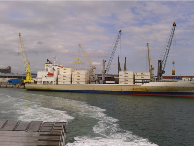 I went to a fascinating talk by Adam Hoyle, Managing Director, Tradax Group Ltd, on Corporate Best Practice in Public Sector Bidding. I thought there were a number of lessons that apply more generally to running all kinds of projects that would be worth sharing.
I went to a fascinating talk by Adam Hoyle, Managing Director, Tradax Group Ltd, on Corporate Best Practice in Public Sector Bidding. I thought there were a number of lessons that apply more generally to running all kinds of projects that would be worth sharing.
Seven best practice tips
- Don’t start projects unless they align with your overall strategy
- Make sure you have thought through exactly what decision-making authority each person involved should have, and that this has been clearly communicated and understood
- Give everyone involved a clear written briefing pack at the start, providing them with all the basic information about the project that they will require
- Standardise what you can – but everything that is standardised needs an owner who takes their ownership seriously
- Think hard about what information would really make a difference to your performance if you had it, and work creatively (legally of course) to get it – for example using FoI requests
- Use the information you have intelligently – there is probably much more that you can learn than is immediately obvious, if you put it all together
- Transitions between teams – for example on winning a bid, or starting to operate an asset – are high-risk boundaries, which need careful planning to make sure they go smoothly
For the last few weeks I have been posting about general principles of governance. Let’s turn to a practical example: How do those principles apply to programme management? There is of course no one ‘right way’ – it depends on the context. However, there definitely are ‘wrong’ ways, and they are all too common!
Most programmes have a Programme Director, and most have a Programme Board. What are their roles, and how should they be related?
Programme Board
The Programme Board should be a fundamental part of the governance structure. There would be no point in it being there unless it makes decisions. To do that, it must be given authority by some other body, which must itself have the authority to do that. Programme Boards typically have as part of their role resolving cross-functional issues for the programme. Consequently, they will normally be set up to report to a committee within the governance structure which itself has cross-functional representation. If the Programme Board is unable to resolve an issue which comes to it, normally its parent will need to. If a Programme Board were to report to an individual, it would be hard to see how that individual could more effectively resolve any cross-functional issue that had to be escalated.Programme Director
The Programme Director’s role will vary in detail between programmes, but fundamentally he or she is the person accountable for making sure that the expected outcomes of the programme are delivered within the constraints agreed. That leads us to two further points. First, if they are accountable, who will hold them to account? That is another part of the role of the Programme Board. The Programme Director will present progress reports, papers for decision, etc to the Programme Board, to enable them to do that. A corollary is that the Programme Director should be appointed, or at least confirmed, by the Programme Board, which will also delegate authority. If things are not going well, it is the Programme Board that must decide whether a change of Programme Director is required. Second, what is the nature of the relationship between the Programme Director and the Programme Board? Essentially it is like a contract. The Programme Board is the customer for the programme, approving the programme requirements. The Programme Director represents the delivery team - the contractor, if you will - and needs to make sure that sufficient time and resources are allocated to the programme to deliver the requirements. Clearly making the two join up may require negotiation. If there are subsequent changes to requirements, agreeing how to accommodate these – extra resource, recognising more risk, delay or reduced quality – will require a further negotiation. Remember, accountability and authority need to go together. Just as with the CEO and a company Board, it is clear that the Programme Director has a fundamentally different role to that of the Programme Board, and to blur these distinctions will introduce conflicts of interest. Of course the Programme Director will normally attend Programme Boards, although that does not mean that they have to be a member (and the different roles are clearer if they are not). Either way, though, they should never be the Chair: they would have a clear conflict of interest. At best they would be tempted to steer the agenda away from certain issues, and it would become impossible for the Board to be effective in holding them to account. No-one should be asked to mark their own homework! It follows that the members of the Programme Board should not normally be junior to the Programme Director, and certainly should not be his or her direct reports. Of course there is a place for meetings of the Programme Team – but those are progress meetings, not Programme Boards. Do your Programme Boards follow these rules?
A couple of weeks ago, I had an evening out at the opera. I’d never encountered this on previous visits, but throughout the performance, there was a lady at the side of the stage translating the sung words into sign language. At the time I thought it rather odd – why would deaf people come to the opera at all? In any case, the words were displayed in English text over the top of the stage. Was this accessibility gone mad?
That prompted me to do a little research, and to realise that there are many reasons why there might be deaf people in the audience: from the obvious-if-you-think-about-it possibility that they might be with partners who are not deaf, to the much more important facts that most deaf people have some hearing and may well enjoy music (and even if they have no hearing, may find musical enjoyment in feeling the vibrations), and the more profound realisation that for some deaf people the English spoken and written around them may be ‘foreign’ compared to sign language.
Assumptions
All too often, we make assumptions about how other people see things. In this case, the conflict between my assumptions and the evidence led me to investigate, and find out that my assumptions were wrong, but much of the time our assumptions go unchallenged, and so un-investigated. In change projects, this is a particular danger. People who are feeling threatened or alienated by a change may be unwilling to point out that wrong assumptions are being made, even if they are not assuming that “management must have thought of that – it’s not for me to say”. Change managers must try to unearth conflicts like this by building relationships widely, and giving people at all levels encouragement to bring their concerns into the open. Change projects often fail, at least to some degree. I wonder how often that is because the manager did not realise, or bother to find out why, the assumptions were in conflict with the evidence. [contact-form][contact-field label='Name' type='name' required='1'/][contact-field label='Email' type='email' required='1'/][contact-field label='Website' type='url'/][contact-field label='Comment' type='textarea' required='1'/][/contact-form] A recent client experience came to mind when I read the following blog post:
http://sethgodin.typepad.com/seths_blog/2013/12/broken-english.html.
Seth says “you will be misunderstood”, and broadly speaking I agree with him: we all interpret what we hear in the context of our own experiences, however careful the speaker, and those experiences are all different. But I think is important to remember that there are degrees of misunderstanding; not all misunderstandings are equal.
My client had started a change project which was running into difficulty. As I started to talk to his staff, it became clear that they all had slightly different understandings of the objectives of the project. Not only did that mean that there was confusion about where they were trying to get to as a whole, but it also meant that the various workstreams were unlikely to join up.
You won’t be surprised to hear that there was not much formal documentation for the project. I’m sure my client felt he had explained what he wanted very clearly – and if he had been on the receiving end, I am certain that he would have understood himself perfectly. But his audience was not him, and he had not taken the additional step of asking his audience to play back to him to check their understanding.
One of the most important tasks for any project manager is to make sure that project objectives are defined clearly, and that everyone understands them. A key skill for project managers is therefore to be able to put things into simple, unambiguous language that fits the background and culture of everyone in the team. They must be good translators: there may still be some misunderstandings, but if they can’t reduce them to a very low minimum by adapting their language (and their listening) to their different audiences, they will not be effective. Just look what happened at Babel!
A recent client experience came to mind when I read the following blog post:
http://sethgodin.typepad.com/seths_blog/2013/12/broken-english.html.
Seth says “you will be misunderstood”, and broadly speaking I agree with him: we all interpret what we hear in the context of our own experiences, however careful the speaker, and those experiences are all different. But I think is important to remember that there are degrees of misunderstanding; not all misunderstandings are equal.
My client had started a change project which was running into difficulty. As I started to talk to his staff, it became clear that they all had slightly different understandings of the objectives of the project. Not only did that mean that there was confusion about where they were trying to get to as a whole, but it also meant that the various workstreams were unlikely to join up.
You won’t be surprised to hear that there was not much formal documentation for the project. I’m sure my client felt he had explained what he wanted very clearly – and if he had been on the receiving end, I am certain that he would have understood himself perfectly. But his audience was not him, and he had not taken the additional step of asking his audience to play back to him to check their understanding.
One of the most important tasks for any project manager is to make sure that project objectives are defined clearly, and that everyone understands them. A key skill for project managers is therefore to be able to put things into simple, unambiguous language that fits the background and culture of everyone in the team. They must be good translators: there may still be some misunderstandings, but if they can’t reduce them to a very low minimum by adapting their language (and their listening) to their different audiences, they will not be effective. Just look what happened at Babel!
[caption id="" align="alignright" width="300"] English: neck of bottle of champagne (Photo credit: Wikipedia)[/caption]
What? Don’t you mean success?
Well, no – although that is worth celebrating too.
I came across the idea that you should celebrate failure recently in “Co-active Coaching”[1], and it makes a lot of sense. People rarely fail at things because they didn’t really try – or at least not at things that matter. First they had to find the courage to attempt something which they knew might to expose them to failure. Then, wanting to avoid failure, they tried hard, probably attempting things they had never done before. Finally they had to admit they had failed - even though in the process they had probably achieved more than they ever thought possible. All of those things are difficult, and worthy of celebration in themselves.
But there is more to it than that. Failure is an excellent teacher! When you fail, you have to face up to things you tried which did not work. Often you will want to understand why they did not work, and this may lead to more success next time.
There is also a less obvious reason. When we are criticised, blamed and shamed for failing, it usually has the desired effect of making us very keen to avoid failing again. Unfortunately, the consequences of that very understandable urge are not necessarily to make us try harder. We are very likely to learn to avoid taking the risky option in the first place, or to limit the options we consider only to the ones which appear ‘safe’.
You can’t stop failure hurting, but instead of adding to the hurt, celebrate failure – the courage, the effort, the learning involved – and at the same time create a culture in which even risky options can be seriously considered.
English: neck of bottle of champagne (Photo credit: Wikipedia)[/caption]
What? Don’t you mean success?
Well, no – although that is worth celebrating too.
I came across the idea that you should celebrate failure recently in “Co-active Coaching”[1], and it makes a lot of sense. People rarely fail at things because they didn’t really try – or at least not at things that matter. First they had to find the courage to attempt something which they knew might to expose them to failure. Then, wanting to avoid failure, they tried hard, probably attempting things they had never done before. Finally they had to admit they had failed - even though in the process they had probably achieved more than they ever thought possible. All of those things are difficult, and worthy of celebration in themselves.
But there is more to it than that. Failure is an excellent teacher! When you fail, you have to face up to things you tried which did not work. Often you will want to understand why they did not work, and this may lead to more success next time.
There is also a less obvious reason. When we are criticised, blamed and shamed for failing, it usually has the desired effect of making us very keen to avoid failing again. Unfortunately, the consequences of that very understandable urge are not necessarily to make us try harder. We are very likely to learn to avoid taking the risky option in the first place, or to limit the options we consider only to the ones which appear ‘safe’.
You can’t stop failure hurting, but instead of adding to the hurt, celebrate failure – the courage, the effort, the learning involved – and at the same time create a culture in which even risky options can be seriously considered.
 English: neck of bottle of champagne (Photo credit: Wikipedia)[/caption]
What? Don’t you mean success?
Well, no – although that is worth celebrating too.
I came across the idea that you should celebrate failure recently in “Co-active Coaching”[1], and it makes a lot of sense. People rarely fail at things because they didn’t really try – or at least not at things that matter. First they had to find the courage to attempt something which they knew might to expose them to failure. Then, wanting to avoid failure, they tried hard, probably attempting things they had never done before. Finally they had to admit they had failed - even though in the process they had probably achieved more than they ever thought possible. All of those things are difficult, and worthy of celebration in themselves.
But there is more to it than that. Failure is an excellent teacher! When you fail, you have to face up to things you tried which did not work. Often you will want to understand why they did not work, and this may lead to more success next time.
There is also a less obvious reason. When we are criticised, blamed and shamed for failing, it usually has the desired effect of making us very keen to avoid failing again. Unfortunately, the consequences of that very understandable urge are not necessarily to make us try harder. We are very likely to learn to avoid taking the risky option in the first place, or to limit the options we consider only to the ones which appear ‘safe’.
You can’t stop failure hurting, but instead of adding to the hurt, celebrate failure – the courage, the effort, the learning involved – and at the same time create a culture in which even risky options can be seriously considered.
English: neck of bottle of champagne (Photo credit: Wikipedia)[/caption]
What? Don’t you mean success?
Well, no – although that is worth celebrating too.
I came across the idea that you should celebrate failure recently in “Co-active Coaching”[1], and it makes a lot of sense. People rarely fail at things because they didn’t really try – or at least not at things that matter. First they had to find the courage to attempt something which they knew might to expose them to failure. Then, wanting to avoid failure, they tried hard, probably attempting things they had never done before. Finally they had to admit they had failed - even though in the process they had probably achieved more than they ever thought possible. All of those things are difficult, and worthy of celebration in themselves.
But there is more to it than that. Failure is an excellent teacher! When you fail, you have to face up to things you tried which did not work. Often you will want to understand why they did not work, and this may lead to more success next time.
There is also a less obvious reason. When we are criticised, blamed and shamed for failing, it usually has the desired effect of making us very keen to avoid failing again. Unfortunately, the consequences of that very understandable urge are not necessarily to make us try harder. We are very likely to learn to avoid taking the risky option in the first place, or to limit the options we consider only to the ones which appear ‘safe’.
You can’t stop failure hurting, but instead of adding to the hurt, celebrate failure – the courage, the effort, the learning involved – and at the same time create a culture in which even risky options can be seriously considered.
[1] “Co-Active Coaching” By Henry and Karen Kimsey-House, Phillip Sandahl and Laura Whitworth
Spotted from the Portsmouth to Cherbourg ferry – a container ship clearly branded ‘Fyffes’. To anyone in the UK (I’m not sure about elsewhere), that means only one thing: bananas.
How many bananas would you get on a banana boat? The banana boxes you see in supermarkets must be about 50cm x 35cm x 20cm (1/30 cubic metre) and I’d guess that they might hold about 100 bananas – so that’s something like 3000 bananas per cubic metre.
A standard container is about 2.4m x 2.4m x 12m, or 72 cubic metres – so that makes about 200,000 bananas per container. Its hard to tell how many containers there are on the boat, but perhaps 100? So maybe 20,000,000 bananas per ship – one between three for the entire population of the UK. That means we need a ship-load of bananas to arrive in Britain every day to provide the average 2 bananas a week that we each eat.
There are several interesting thoughts that follow from that. The first is simply the incredible logistical feat of providing that many ripe bananas, day in, day out, to shops across the land. Demand takes little account of seasons or weather, and bananas are quite easily damaged. Developing processes which can deliver that volume, in good condition and at the price people expect to pay, while having the resilience to cope with the vagaries of nature, is an impressive achievement. There is little to distinguish between one banana and another though – so its only getting those processes optimised that enables you to compete.
Another is the power of such rough and ready estimates. Starting from easy observations and guesses that anyone could make, we can get a pretty good estimate of shipping requirements: we might be 2x too big or small, but probably not much worse than that. Frequently there is no need for high precision, at least to start with, but the courage to estimate is not always easily found.
A final thought is the power of those little labels, When I was a child, it seemed as though every bunch of bananas had a Fyffes label on it. Fifty years later, the association is still instant. I’m not sure how that creates value for Fyffes (does it?), but the effect is unmistakable!
 What is leadership about? The very word implies movement. Leadership involves helping other people to find the way from A to B, so all leadership is change leadership of some kind. If we are sticking to A, the people may need managing, but there is not much leading involved. You don’t need a leader if you are not going anywhere.
How many times have you heard people say “if its not broken, why fix it?” Probably you have said it yourself at times. Or “I don’t want to upset the apple cart”? No-one likes change – everyone is more comfortable with the status quo. The trouble is, stability is an illusion, at least in the longer term. Everything grows - or it declines. The organisation that does not change positively is doomed eventually to change negatively.
Change is the whole point of leadership. The joke says “How many psychologists does it take to change a light bulb? One, but it has to want to change!” The job of the leader is to have the vision of where to go to, and then to get people to the point where they want to, or at least accept the need for, change.
What is leadership about? The very word implies movement. Leadership involves helping other people to find the way from A to B, so all leadership is change leadership of some kind. If we are sticking to A, the people may need managing, but there is not much leading involved. You don’t need a leader if you are not going anywhere.
How many times have you heard people say “if its not broken, why fix it?” Probably you have said it yourself at times. Or “I don’t want to upset the apple cart”? No-one likes change – everyone is more comfortable with the status quo. The trouble is, stability is an illusion, at least in the longer term. Everything grows - or it declines. The organisation that does not change positively is doomed eventually to change negatively.
Change is the whole point of leadership. The joke says “How many psychologists does it take to change a light bulb? One, but it has to want to change!” The job of the leader is to have the vision of where to go to, and then to get people to the point where they want to, or at least accept the need for, change.
[caption id="" align="alignright" width="300"] Wing mirror VW Fox (Photo credit: Wikipedia)[/caption]
Last week I had to drive my daughter to France to start a year of study at a French University. As you can imagine, the (small) car was packed to the roof with all the things she needed, or at least believed she needed, and which could not possibly get there any other way. Result – the rear view mirror only gave me a view of some pillows, which was not a lot of help. However, I very quickly adjusted to relying entirely on the wing mirrors, and felt reasonably safe even though I was driving on the ‘wrong’ side of the road.
The strange thing was that on the return journey, having unloaded in Nantes, I continued in the same way. It was only chance that I glanced in the direction of the main mirror, and realised that it was (of course) no longer obstructed. Information inertia!
Wing mirror VW Fox (Photo credit: Wikipedia)[/caption]
Last week I had to drive my daughter to France to start a year of study at a French University. As you can imagine, the (small) car was packed to the roof with all the things she needed, or at least believed she needed, and which could not possibly get there any other way. Result – the rear view mirror only gave me a view of some pillows, which was not a lot of help. However, I very quickly adjusted to relying entirely on the wing mirrors, and felt reasonably safe even though I was driving on the ‘wrong’ side of the road.
The strange thing was that on the return journey, having unloaded in Nantes, I continued in the same way. It was only chance that I glanced in the direction of the main mirror, and realised that it was (of course) no longer obstructed. Information inertia!
 Wing mirror VW Fox (Photo credit: Wikipedia)[/caption]
Last week I had to drive my daughter to France to start a year of study at a French University. As you can imagine, the (small) car was packed to the roof with all the things she needed, or at least believed she needed, and which could not possibly get there any other way. Result – the rear view mirror only gave me a view of some pillows, which was not a lot of help. However, I very quickly adjusted to relying entirely on the wing mirrors, and felt reasonably safe even though I was driving on the ‘wrong’ side of the road.
The strange thing was that on the return journey, having unloaded in Nantes, I continued in the same way. It was only chance that I glanced in the direction of the main mirror, and realised that it was (of course) no longer obstructed. Information inertia!
Wing mirror VW Fox (Photo credit: Wikipedia)[/caption]
Last week I had to drive my daughter to France to start a year of study at a French University. As you can imagine, the (small) car was packed to the roof with all the things she needed, or at least believed she needed, and which could not possibly get there any other way. Result – the rear view mirror only gave me a view of some pillows, which was not a lot of help. However, I very quickly adjusted to relying entirely on the wing mirrors, and felt reasonably safe even though I was driving on the ‘wrong’ side of the road.
The strange thing was that on the return journey, having unloaded in Nantes, I continued in the same way. It was only chance that I glanced in the direction of the main mirror, and realised that it was (of course) no longer obstructed. Information inertia!



